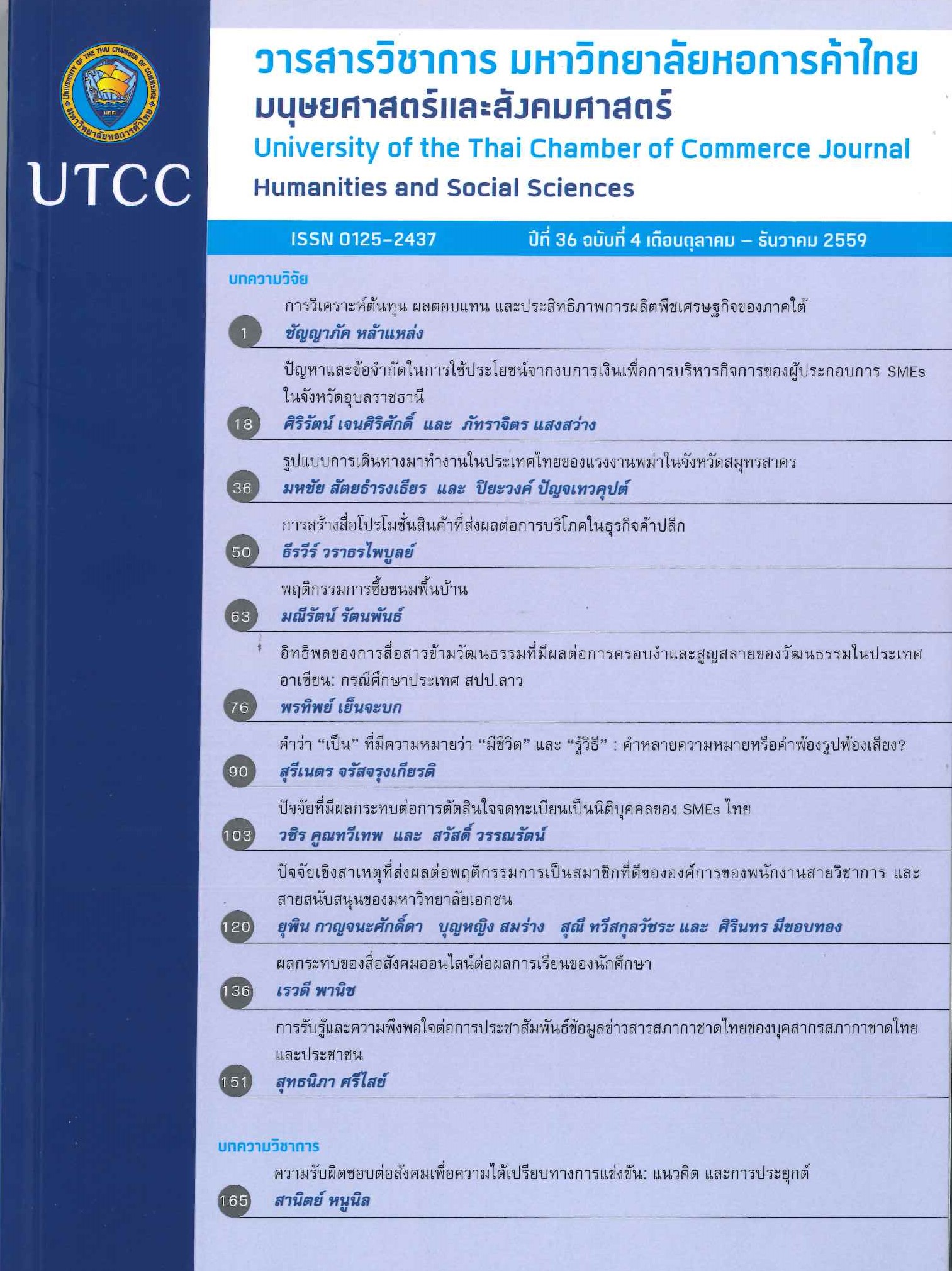The Effects of Social Media on Academic Outcomes
Main Article Content
Abstract
This paper intends to study the effects of using social media on student’s learning performance by applying a Randomized Controlled Trial (RCT) method. Data are sampled from students in the University of the Thai Chamber of Commerce’s Course on Investment and Securities Analysis (EC412) in the first term of 2014. Of the 73 students sampled, 34 were in a control group and 37 were in an experimental group, one represents a class learning with social media and the other without social media. A key finding is that learning with social media leads learning performance to a level 33 percent greater than learning without it. However, an achievement in learning does not depend only on using social media in classroom. Students’ attention and curiosity are the most important achievement factors.
Article Details
ลิขสิทธิ์ของบทความ
ผลงานที่ได้รับการตีพิมพ์ถือเป็นลิขสิทธิ์ของมหาวิทยาลัยหอการค้าไทย ห้ามมิให้นำเนื้อหา ทัศนะ หรือข้อคิดเห็นใด ๆ ของผลงานไปทำซ้ำ ดัดแปลง หรือเผยแพร่ ไม่ว่าทั้งหมดหรือบางส่วนโดยไม่ได้รับอนุญาตเป็นลายลักษณ์อักษรจากมหาวิทยาลัยหอการค้าไทยก่อน
References
Chevapantuchee, Kamonpan. 1992. Brain and learning. 2nd ed. Bangkok: Porn Printing (in Thai).
กมลพรรณ ชีวพันธุศรี. 2546. สมองกับการเรียนรู้. พิมพ์ครั้งที่ 3. กรุงเทพมหานคร: พรการพิมพ์.
Duflo, E., and M. Kremer. 2005. “Use of Randomization in the Evaluation of Development Electiveness.” In Conference on Evaluation and Development Electiveness, 15-16 July 2003, Washington, D.C. 7, 1: 205-232.
Ellis, W.D. 1977. A Source Book of Gestalt Psychology. New York: Humanities Press.
Fox, Dennis. 1983. “Personal Theories of Teaching”. Studies in Higher Education 8, 2: 151-163.
Kajourbutr, S. Kunkawn. 2014. Alarm Panel brain: KunKrown + Kunhuedee + Kunheng Chamnongsri + Dr.viroj [Online]. Available: https://bit.ly/1FlnS6K (in Thai).
ขุนเขา สินธุเสน เขจรบุตร. 2557. เสวนาปลุกสมอง: ขุนเขา + คุณหนูดี + คุณหญิงจำนงศรี +หมอวิโรจน์ [ออนไลน์]. เข้าถึงจาก: https://bit.ly/1FlnS6K
Kanyahoung, Somsan.2012. “Factors Affecting the Use of Social Networking for Student Learning 4th Grade Secondary Education Area Office Area 25.” Master's Thesis. Graduate School, Mahasarakham University (in Thai).
สมสรรค์ กันยาหลง. 2555. “ปัจจัยที่ส่งผลต่อการใช้เครือข่ายสังคมออนไลน์เพื่อการเรียนรู้ของนักเรียน ชั้นมัธยมศึกษาปีที่ 4 สำนักงานเขตพื้นที่การศึกษา มัธยมศึกษา เขต 25.” วิทยานิพนธ์ปริญญามหาบัณฑิต มหาวิทยาลัยมหาสารคาม.
Leangpanich, Sunsanee. 2012. “Student Achievement and Satisfaction from Using Social Networking as a Tool for Teaching and Learning of Third-Year Student in Computer Science.” KKU Research, Khon Kaen University 17, 1: 142-152 (in Thai).
ศันสนีย์ เลี้ยงพานิชย์. 2555. “ศึกษาผลสัมฤทธิ์และความพึงพอใจจากการใช้เว็บเครือข่ายสังคมเป็นเครื่องมือในการจัดการเรียนการสอนของนักศึกษาชั้นปีที่ 3 สาขา วิทยาการคอมพิวเตอร์.” วารสารวิจัย มหาวิทยาลัยขอนแก่น 17, 1: 142-152.
Manuguerra, Maurizio. 2011. Promoting Student Engagement by Integrating New Technology into Tertiary Education [Online]. Available: https://bit.ly/1gZPi91
Panich, Rewadee. 2015. To Study the Use of Social Media and the Education of Teachers and Students to Compare the Use of Social Media has on Learning in the Classroom, Faculty of Economics, University of Thai Chamber of Commerce on 2014. Bangkok: Faculty of Economics, University of Thai Chamber of Commerce (in Thai).
เรวดี พานิช. 2558. การศึกษาพฤติกรรมการใช้สื่อสังคมออนไลน์ของอาจารย์และนักศึกษาและการศึกษาเปรียบเทียบผลการใช้สื่อสังคมออนไลน์ที่มีต่อการเรียนรู้ในชั้นเรียน คณะเศรษฐศาสตร์ มหาวิทยาลัยหอการค้า ปีการศึกษา 2557. กรุงเทพมหานคร: คณะเศรษฐศาสตร์ มหาวิทยาลัยหอการค้าไทย.
Panich, Wijarn. 2012. Way of Learning for Students in the 21st Century [Online]. Available: https://www.teenpath.net/download.asp?ID=2211 (in Thai).
วิจารณ์ พานิช. 2555. วิถีสร้างการเรียนรู้เพื่อศิษย์ในศตวรรษที่ 21 [ออนไลน์]. เข้าถึงจาก: https://www.teenpath.net/download.asp?ID=2211
Panich, Wijarn. 2013. Learning How it Happened: 12. Development of the Students and the Classroom Atmosphere: the Theory [Online]. Available: https://www.gotoknow.org/posts/522911 (in Thai).
วิจารณ์ พานิช. 2556. การเรียนรู้เกิดขึ้นอย่างไร: ๑๒. พัฒนาการของนักศึกษาและบรรยากาศในชั้นเรียน: ทฤษฎี [ออนไลน์]. เข้าถึงจาก: https://www.gotoknow.org/posts/522911
Panich, Wijarn. 2013. Teacher to Pupil Back to the Classroom Building. Bangkok: S.R. Printing - Mass Products (in Thai).
วิจารณ์ พานิช. 2556. ครูเพื่อศิษย์ สร้างห้องเรียนกลับทาง. กรุงเทพมหานคร: เอส.อาร์.พริ้น-ติ้ง แมสโปรดักส์.
Qiping, Shen. et al. 2007. “A Comparative Study of Student Performance in Traditional Mode and Online Mode of Learning” Computer Applications in Engineering Education 15, 1: 30-40.
Race, V. 2014. Alarm Panel Brain: KunKrown + Kunhuedee + Kunheng Chamnongsri + Dr.viroj [Online]. Available: https://bit.ly/1FlnS6K (in Thai).
วนิษา เรซ. 2557. เสวนาปลุกสมอง: ขุนเขา + คุณหนูดี + คุณหญิงจำนงศรี + หมอวิโรจน์ [ออนไลน์].เข้าถึงจาก: https://bit.ly/1FlnS6K
Sams and Bergmann. 2012. Flip Your Classroom [Online]. Available: https://bit.ly/1bXR9Zq
Saneha, Wilaiporn and Utayanwutigul, Napaporn. “Analysis of The Use of iPad (in Teaching and Learning) of Accounting Students in University of the Thai Chamber of Commerce.” University of the Thai Chamber of Commerce Journal 33, Special Issue: 174-184 (in Thai).
วิไลพร เสน่หา และนภาพร อุทยานวุฒิกุล. 2556. “การวิเคราะห์การใช้ iPad ในการเรียนการสอนของนักศึกษาคณะบัญชี มหาวิทยาลัยหอการค้าไทย.” วารสารวิชาการ มหาวิทยาลับหอการค้าไทย 33, ฉบับพิเศษ: 174-184.
Singhasivanon, Pratab and Kaewkangvan, Joranit. 2011. Formed Clinical Research. Textbook of Clinical Research [Online]. Available: https://bit.ly/1LeFDcI (in Thai).
ประตาป สิงหศิวานนท์ และจรณิต แก้วกังวาน. 2554. รูปแบบการวิจัยทางคลินิก [ออนไลน์]. เข้าถึงจาก: https://bit.ly/1LeFDcI
Skinner, B. F. 1938. The Behavior of Organisms: An Experimental Analysis. New York: Appleton-Century.
Statistic Brain. 2013. Statistic Brain Research Institute [Online]. Available: https://bit.ly/18KIwd2
Statistic Brain. 2014. Statistic Brain Research Institute [Online]. Available: https://bit.ly/18KIwd2
Thailand. Ministry of Information and Communication Technology, and Thammasat University Research and Consultancy Institute. 2014. (Draft) The Third Thailand Information and Communication Technology Master Plan 2014-2018 [Online]. Available: https://bit.ly/1JpflBu (in Thai).
กระทรวงเทคโนโลยีสารสนเทศและการสื่อสาร, มหาวิทยาลัยธรรมศาสตร์. สถาบันวิจัยและให้คำปรึกษา, และสวมธ.. 2557. แผนแม่บทเทคโนโลยีสารสนเทศและการสื่อสาร (ฉบับที่3) ของประเทศไทย พ.ศ.2557-2561 (ร่าง) [ออนไลน์]. เข้าถึงจาก: https://bit.ly/1JpflBu
Thailand. National Electronics and Computer Technology Center (NECTEC). 2014. Internet Users; How to be the Source of Information on the Internet [Online]. Available: https://bit.ly/1Ac6PUs (in Thai).
ศูนย์เทคโนโลยีอิเล็กทรอนิกส์และคอมพิวเตอร์แห่งชาติ(เนคเทค). 2557. Internet Users; วิธีการได้มาของข้อมูลผู้ใช้อินเทอร์เน็ต [ออนไลน์]. เข้าถึงจาก: https://bit.ly/1Ac6PUs
Thorndike, E. L.. 1898. Animal Intelligence: An Experimental Study of the Associative Processes in Animals [Online]. Available: https://bit.ly/1O2gkuX

